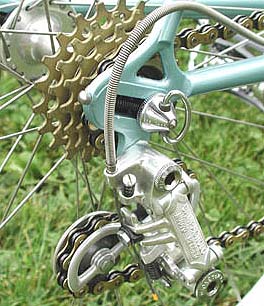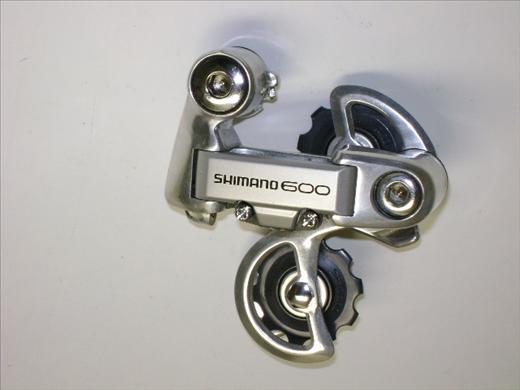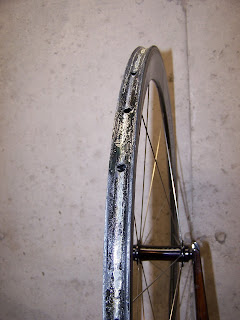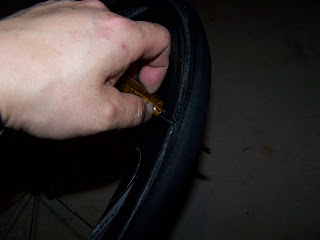Recently I had discussions with two of my friends about what direction to go with when it came to groups. Since ErgoPower came along I've been a diehard Campy fan, liking the separation of brake and gear (levers, that is), the ability to dump multiple gears, and the ability to once again run a full Campy bike.
See, before that, somewhat unbelievably, I used Suntour derailleurs, Dia Compe brakes (whose company was so close to Suntour that they made Suntour brakes), Sugino (Suntour cranks and bottom brackets), and the ubiquitous new Sedisport chain (probably the quietest chain out there, cheap, and flexy enough to shift well).
At that time racers could select between Campy, the acknowledged leader, Suntour, the Far East Campy, or Shimano, the, err, Far East bastard son who kept thinking up wacky ideas because no one could really improve on the Campy level quality. I mean, how could you develop higher quality metals, better bearings, or more durable components? You couldn't. So companies either tried to be like them (Suntour) or make functionally different things (Shimano).
One of Shimano's ideas involved a freewheeling chainring (the crankarms freewheeled separately from the chainrings) combined with a fixed gear rear 5 speed freewheel. Since the cranks turned whenever the bike moved, you could shift whenever the bike moved, even if you weren't pedaling. Tellingly, Shimano had to use a solid wire for a shift cable, with a lever that could push or pull it. A regular cable was too unpredictable, but the solid wire had absolutely no stretch or compression. Shimano added stops for each gear - it was indexed.
I had started out, in my pre-racing days, subscribing to the Campy Way. Cold forged aluminum, super high quality bearing races, one level of quality and performance (high), beautiful old world craftmanship, and a link to the man that made bike drivetrains what they were - Tullio Campagnolo.
There were other Campy features - the 144mm bolt circle diameter for one. Suntour used it too, like a little brother copying his older one, but Shimano used 130mm, because, well, because no one else was using it. Campy's bottom bracket axle taper worked well for their cranks, and Suntour's also, but Shimano used the Japanese standard, and you had to use Shimano BBs with Shimano cranks.
I digress, slightly.
Of course my first race bike had Campy derailleurs and shifters. I couldn't afford everything else (most of the bike was Excel Rino, and it came with Modolo brakes), but that would come with time. I moved to a Shimano parallelogram rear derailleur when I went to a Suntour bar end shifter (complete with the wiggly stainless steel cable housing) because such shifters require a bit more precision than the predictably vague Campy rear derailleur. The stainless housing didn't help any, but it was cool looking so I used it. Plus I could lube the cable simply by pouring TriFlow all over the housing.
Ironically that's when I could afford a Campy crankset, and so I paired my odd drivetrain with a Campy crankset and a Super Record front derailleur, one still connected to a downtube shifter, and it shifted immaculately. How could it not, the cable was about 2 feet long and probably twice the thickness of today's derailleurs, and the return spring was one for men, not boys, and required the shifter to tug the shifter pretty hard.
Wait, you ask. What's a parallelogram derailleur? And why wouldn't a Campy rear derailleur work with a bar end shifter?
Get your popcorn, gather 'round, and let's learn a little history.
Before indexed shifting ("click-shifting"), all the different companies worked with all the different companies. Riders would readily mix shifters, derailleurs, cranks, chains (most groups had no specific chain). In fact, groups were so non-specific (i.e. universal) that Campy, Shimano, and Suntour would leave the chain and possibly the freewheel up to other manufacturers, usually ones that did a better job of it. Sedisport made great chains, and Regina made the most in-demand freewheels (there were no cassettes for a long time).
 Campy's initial parallelogram rear derailleur. I refer to the two derailleur plates as the "parallelogram". (Image from Sheldonbrown.com)
Campy's initial parallelogram rear derailleur. I refer to the two derailleur plates as the "parallelogram". (Image from Sheldonbrown.com)You can see some non-derailleur items in this picture, like the Regina freewheel (with no special shifting ramps - the little groove at the top of each cog was their "shifting secret"), the Regina chain (it's sort of rough looking, like a BMX chain), and finally the floppiest housing ever, the stainless steel uber-expensive derailleur housing I lusted after.
On the derailleur, though, you'll notice something much more significant. Note how on the Campy derailleur the two plates drop straight down from the upper derailleur bolt. Due to the pivot axes of the plates, the derailleur pulleys will initially drop as they move inward, then rise back up a bit. The pulley cage has to rotate to keep the pulleys closer to the rear cogs.
With this design it's difficult to get the upper pulley closer than, say, two or three links from the cogs. In fact, the obscured bit of chain, between the top pulley and the freewheel, only touches air. This means that you have a lot of slop when you shift. This necessitated the Campy Overshift, a technique everyone learned where you shift past the intended position to get the reluctant chain to move off its starting cog, and then shift it back a bit so the pulley lined up with the target cog.
 Shimano's parallelogram. I ran this type of derailleur for many years. Note the L-shaped piece at the top, which turns the parallelogram on its side. (Image from VeloBase.com who got it from eBay seller coffeeride)
Shimano's parallelogram. I ran this type of derailleur for many years. Note the L-shaped piece at the top, which turns the parallelogram on its side. (Image from VeloBase.com who got it from eBay seller coffeeride)
With this design it's difficult to get the upper pulley closer than, say, two or three links from the cogs. In fact, the obscured bit of chain, between the top pulley and the freewheel, only touches air. This means that you have a lot of slop when you shift. This necessitated the Campy Overshift, a technique everyone learned where you shift past the intended position to get the reluctant chain to move off its starting cog, and then shift it back a bit so the pulley lined up with the target cog.
 Shimano's parallelogram. I ran this type of derailleur for many years. Note the L-shaped piece at the top, which turns the parallelogram on its side. (Image from VeloBase.com who got it from eBay seller coffeeride)
Shimano's parallelogram. I ran this type of derailleur for many years. Note the L-shaped piece at the top, which turns the parallelogram on its side. (Image from VeloBase.com who got it from eBay seller coffeeride)Shimano improved on Campy's design by tilting the two plates so they sit almost horizontal, not vertical. The derailleur pulleys now move back and forth without the downward/upward arc (the arc moves the upper pulley a little more in front of the cog, then back a bit). This lets the upper pulley sit closer to the cogs, and allowed the derailleur to move the chain without necessitating any kind of overshift.
The only problem with this design was that it took an unpredictable amount of cable movement to make said shift. In the middle of the freewheel range, the derailleur was further away from the cogs than at the ends. This derailleur was always a bit iffy on the smallest cogs, and the upper pulley would rub large cogs readily. Using a super long chain would allow the upper pulley to sit closer, but you'd get massive chain bounce in the small ring.
 Suntour's slant parallelogram rear derailleur. I ran Suntours towards the end of my barend days, just before Ergo. Note how the parallelogram points up towards the upper pivot bolt. (Image from Kinetics)
Suntour's slant parallelogram rear derailleur. I ran Suntours towards the end of my barend days, just before Ergo. Note how the parallelogram points up towards the upper pivot bolt. (Image from Kinetics)Suntour made one more improvement to the parallelogram soap opera - they tilted it. Note how the two plates now tilt a bit, as opposed to the flat profile the Shimano derailleur presents to you.
This immense update allowed the derailleur pulleys to follows the slope of the cogs.
Let's repeat that, because it's important.
The slanted parallelogram design allows the upper derailleur pulley to follow the slope of the cogs as it moves across the cogs.
A given amount of cable travel would move the derailleur a given distance. It shifted well at all ranges of the freewheel, and it could handle larger cogs than, say, the Shimano design, typically two more teeth than a similarly designed derailleurs.
Although the ingredients were in place for the next step, Suntour couldn't, or wouldn't take it. The bicycle drivetrain world sat in stasis.
Then came the fateful day when Suntour's slant parallelogram (second) patent expired.
Shimano had obviously been planning changes around this date for some time, because shortly after Suntour's excellent rear derailleur design became available for anyone and everyone, they introduced a high end index shifting system. The new system had a few significant features:
1. Shimano invented an upper derailleur pulley that had lateral movement, to allow it to automatically adjust for small derailleur misalignments.
2. They used a compressionless housing, one that didn't flex at all when tensioned. This meant that any shifter movement translated into cable movement, not housing flex. Said housing also had a slippery lining, one that the uber-cool stainless housings lacked.
3. They developed a low-friction (small diameter) cable that slid easily in the above lined housing.
4. They combined this with their own chain and cog design, one developed from their Uniglide line of twisted teeth cassettes and bulging sidewall plate chains. These new products helped the derailleur move the chain sideways under pressure.
5. Shimano started off the acronym war with the first widely used cycling acronym: SIS, for Shimano Index System.
The system worked.
With indexing came a whole host of related issues. Suddenly companies needed to have predictable performance from the previously ancillary pieces. First off, the "sloppy" top pulley became a necessity so that minor adjustments to derailleur position happened automatically. Second, the chain and the cogs had to work together. And finally, the system had to use compressionless housing, and a cable that, once broken in, didn't stretch at all.
Shimano started specifying specific chains and cassettes, and everyone rushed to make their version of non-stretch derailleur cable, non-compression housing, better shifting rear cogs, a spec chain, and some wiggly upper derailleur pulley.
For a while only Shimano had a system that worked well. Suntour's first attempt failed miserably, and Campy, well, Campy stubbornly stuck with its old, outdated rear derailleur design, and that would never, ever index properly.
Their market share dropped accordingly.
Shimano happened to introduce SIS just as the mountain bike craze hit the public. Suddenly a whole bunch of people who had no idea how to shift were buying bikes with 21 or 24 speeds. They needed indexing.
Suntour almost made their system work, survived by the skin of their teeth. Campy trudged along, selling systems to the lonely road riders in a sea of mountain bikers.
Then, in the late 80s, Shimano came out with STI, their brake lever - shift lever combination. Racers screamed for similar systems from Suntour - the Tour du Pont was won when an STI equipped Lance accelerated away from a downtube shifting (or not, in this case) Raul Alcala.
Racers had to have a bar mounted shifter. (And why Alcala didn't have a bar end shifter belies belief, since Suntour had an excellent bar end shifter, but that's another question).
Campy finally, belatedly, introduced the Ergopower levers, adopted the slant parallelogram derailleur design, and pulled themselves from the edge of extinction.
Suntour, with its failed Command Shifter (and no other viable ideas other than the Barcon), died an inglorious death. Their inability to invent a brifter killed them.
The world now is a bit different. No more Suntour. People talk about "drivetrain kits". Brifters. No one knows what freewheels are anymore.
And, finally, a new company popped up: SRAM.
So when someone starts thinking about road bikes and what drivetrain to use, you have to decide between Campy, Shimano, and SRAM.
Which one should you get?
Stay tuned for Part 2.




























